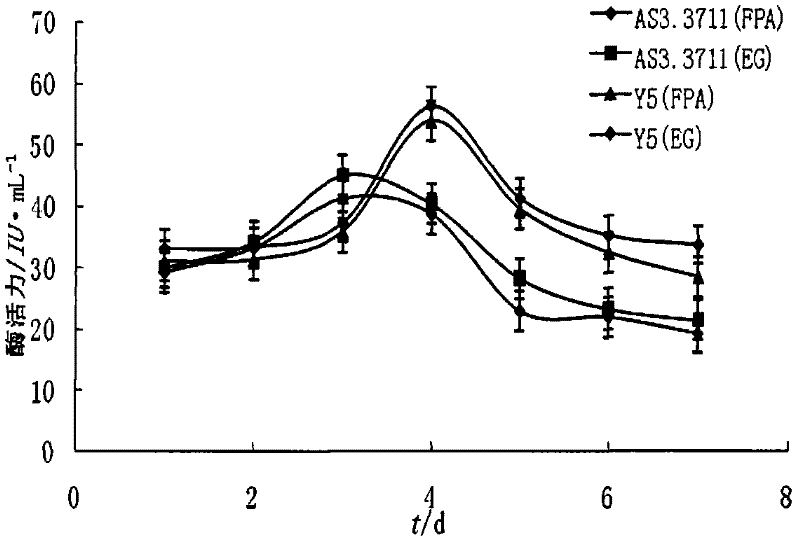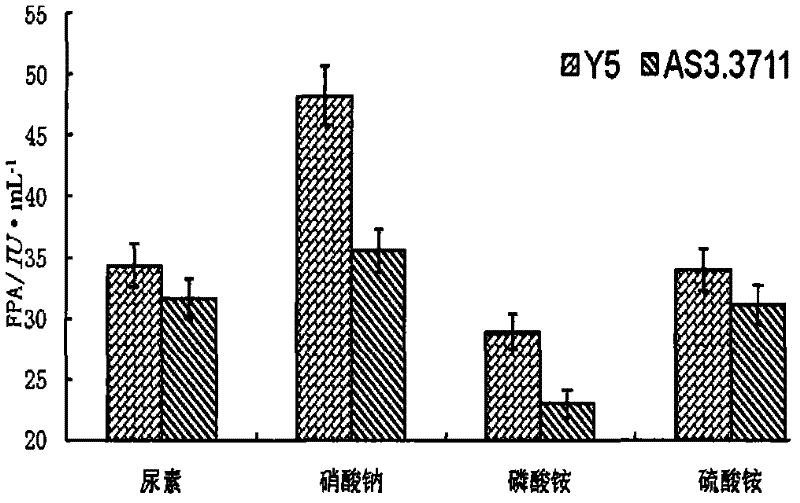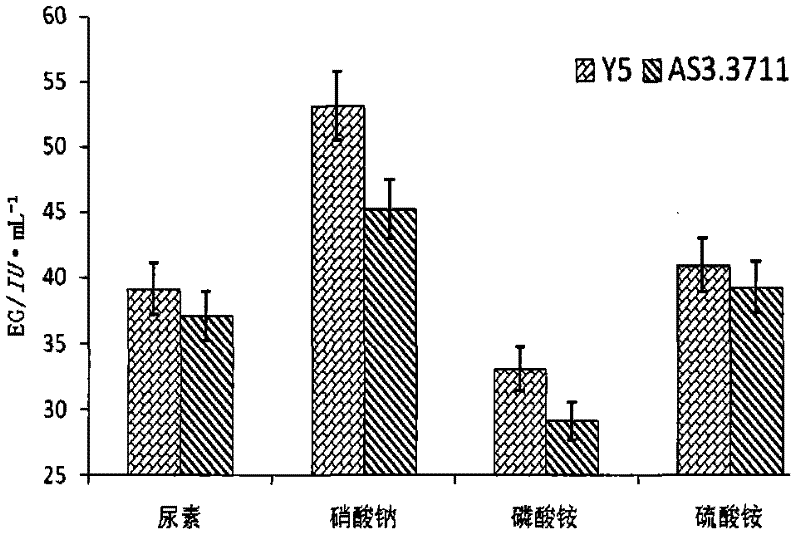Penicillium ochrochloron Y5 and microbial inoculum thereof for degrading straw
A technology of Penicillium ochraceus and inoculum, which is applied in the field of microbial inoculants for efficiently degrading straw, can solve the problems of no research report on microbial inoculants, no stacking, low temperature, drought, nutritional imbalance, and restriction of efficient utilization of straw resources. , to achieve the effect of significant effect and high efficiency degradation ability
- Summary
- Abstract
- Description
- Claims
- Application Information
AI Technical Summary
Problems solved by technology
Method used
Image
Examples
Embodiment 1
[0046] Example 1 strain screening and its ability to degrade cellulose
[0047] After being cultured on CMC solid medium for 48 hours, 12 strains of fungi were selected according to the diameter of the transparent circle and the ratio of the diameter of the transparent circle to the colony diameter (D / d). The best degradation effect was Y5, and when Y5 was inoculated on the inorganic salt medium containing wheat straw powder as the only carbon source, it could grow rapidly and produce a degradation circle (Table 1).
[0048] The diameter of the transparent circle of Penicillium ochregreen Y5 strain is 29.1mm, the diameter of the colony is 7.8mm, and the ratio D / d of the two is 3.73, which is much larger than that of other strains. It shows that it has a strong ability to degrade wheat straw cellulose.
[0049] Table 1 The diameters of colonies and phosphate-dissolving circles of 12 strains of cellulose-degrading fungi on solid medium of inorganic salts (CMC)
[0050]
[0...
experiment example 2
[0053] Experimental Example 2 Effects of Different Culture Conditions on Cellulase Activity of Bacterial Strain Y5
[0054] (1) Enzyme activity of strain Y5 changes with culture time
[0055] Strain Y5 was cultured in liquid with wheat straw powder as the only substrate, and strain AS3.3711 (purchased from the General Microorganism Center of China Microbiological Culture Collection Management Committee) was used as a control to determine the total enzyme activity (FPA) of strain Y5 and AS3.3711. ) and endonuclease activity (EG) ( figure 1 ). The data showed a significant difference between the two (p=0.01). When cultured for 3 days, the control strain FPA and EG reached the maximum at the same time, respectively 41.2IU / mL and 44.9IU / mL, and the two enzyme activities decreased rapidly in the next 3 days, and stabilized at 20IU / mL on the 6th and 7th days about. The FPA and EG activities of the degrading bacteria Y5 increased slowly within 3 days before the culture, and the t...
experiment example 3
[0063] Experimental Example 3 Ability Experiment of Strain Y5 to Degrade Wheat Straw
[0064] Under the condition of liquid culture at 25°C, the contents of cellulose, hemicellulose and lignin in wheat straw of strain Y5 with different culture time were measured, the results showed ( Figure 7-Figure 9 ), compared with CK and the control strain AS3.3711, strain Y5 has a significant effect on the degradation of cellulose and hemicellulose (p=0.01). Moreover, the degradation period of Y5 to cellulose and hemicellulose is mainly distributed in the 2nd to 4th day. The cellulose content of the straw-using strain Y5 decreased by 10.6% and the hemicellulose content decreased by 12.6% within 2 days, while the control strain AS3.3711 The content of cellulose and hemicellulose decreased by 3.2% and 3.4% respectively in the corresponding period. At the end of the culture, Y5 reduced the cellulose and hemicellulose of wheat straw by 14.2% and 15.7% of the total weight respectively, while...
PUM
 Login to View More
Login to View More Abstract
Description
Claims
Application Information
 Login to View More
Login to View More - R&D
- Intellectual Property
- Life Sciences
- Materials
- Tech Scout
- Unparalleled Data Quality
- Higher Quality Content
- 60% Fewer Hallucinations
Browse by: Latest US Patents, China's latest patents, Technical Efficacy Thesaurus, Application Domain, Technology Topic, Popular Technical Reports.
© 2025 PatSnap. All rights reserved.Legal|Privacy policy|Modern Slavery Act Transparency Statement|Sitemap|About US| Contact US: help@patsnap.com



